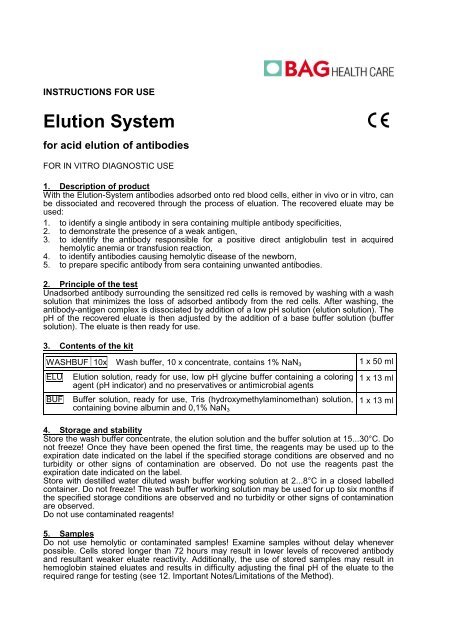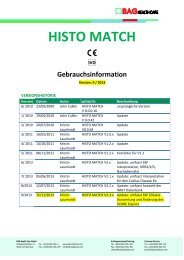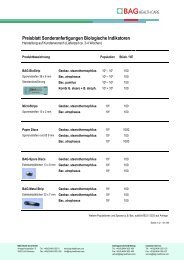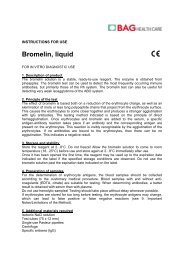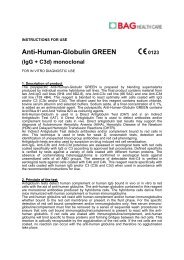Novaclone Anti-D BPZ
Novaclone Anti-D BPZ
Novaclone Anti-D BPZ
You also want an ePaper? Increase the reach of your titles
YUMPU automatically turns print PDFs into web optimized ePapers that Google loves.
INSTRUCTIONS FOR USE<br />
Elution System ��<br />
for acid elution of antibodies<br />
FOR IN VITRO DIAGNOSTIC USE<br />
1. Description of product<br />
With the Elution-System antibodies adsorbed onto red blood cells, either in vivo or in vitro, can<br />
be dissociated and recovered through the process of eluation. The recovered eluate may be<br />
used:<br />
1. to identify a single antibody in sera containing multiple antibody specificities,<br />
2. to demonstrate the presence of a weak antigen,<br />
3. to identify the antibody responsible for a positive direct antiglobulin test in acquired<br />
hemolytic anemia or transfusion reaction,<br />
4. to identify antibodies causing hemolytic disease of the newborn,<br />
5. to prepare specific antibody from sera containing unwanted antibodies.<br />
2. Principle of the test<br />
Unadsorbed antibody surrounding the sensitized red cells is removed by washing with a wash<br />
solution that minimizes the loss of adsorbed antibody from the red cells. After washing, the<br />
antibody-antigen complex is dissociated by addition of a low pH solution (elution solution). The<br />
pH of the recovered eluate is then adjusted by the addition of a base buffer solution (buffer<br />
solution). The eluate is then ready for use.<br />
3. Contents of the kit<br />
WASHBUF 10x Wash buffer, 10 x concentrate, contains 1% NaN3<br />
ELU Elution solution, ready for use, low pH glycine buffer containing a coloring<br />
agent (pH indicator) and no preservatives or antimicrobial agents<br />
BUF Buffer solution, ready for use, Tris (hydroxymethylaminomethan) solution,<br />
containing bovine albumin and 0,1% NaN3<br />
1 x 50 ml<br />
1 x 13 ml<br />
1 x 13 ml<br />
4. Storage and stability<br />
Store the wash buffer concentrate, the elution solution and the buffer solution at 15...30°C. Do<br />
not freeze! Once they have been opened the first time, the reagents may be used up to the<br />
expiration date indicated on the label if the specified storage conditions are observed and no<br />
turbidity or other signs of contamination are observed. Do not use the reagents past the<br />
expiration date indicated on the label.<br />
Store with destilled water diluted wash buffer working solution at 2...8°C in a closed labelled<br />
container. Do not freeze! The wash buffer working solution may be used for up to six months if<br />
the specified storage conditions are observed and no turbidity or other signs of contamination<br />
are observed.<br />
Do not use contaminated reagents!<br />
5. Samples<br />
Do not use hemolytic or contaminated samples! Examine samples without delay whenever<br />
possible. Cells stored longer than 72 hours may result in lower levels of recovered antibody<br />
and resultant weaker eluate reactivity. Additionally, the use of stored samples may result in<br />
hemoglobin stained eluates and results in difficulty adjusting the final pH of the eluate to the<br />
required range for testing (see 12. Important Notes/Limitations of the Method).
6. Additional materials required<br />
Isotonic NaCl solution<br />
Aqua dest.<br />
Disposable glass test tubes (75 x 12 mm)<br />
Transfer pipettes<br />
Waterbath or incubator (37°C 1°C)<br />
Centrifuge<br />
Reagents for testing of the eluate<br />
7. Wash buffer dilution<br />
Dilute the concentrated wash buffer by adding one volume of the concentrated wash buffer to<br />
nine volumes of Aqua dest. This wash buffer working solution should be stored at 2...8°C in a<br />
closed container. This solution may be used for up to six months if no turbidity or other signs<br />
of contamination are observed during storage.<br />
Use of a ”cold” wash buffer working solution may further minimize antibody dissociation during<br />
the wash phase of the procedure.<br />
8. Elution procedure<br />
1. Perform a direct antiglobulin test on the red cell sample that has been sensitized with<br />
antibody either in vivo or in vitro. Record result.<br />
2. Centrifuge the sensitized red cell sample in a clean, labeled test tube. Remove the excess<br />
plasma or serum and wash the red cells once with isotonic saline.<br />
This procedure is based on a recommended sample volume of 1 ml of packed red cells.<br />
However, smaller volumes may be used if the proportionate ratio of packed cells to<br />
elution solution is maintained. Use of a packed cell volume less than 1 ml will result in a<br />
smaller final volume of eluate available for testing.<br />
3. Transfer 1 ml of packed red cells to a clean, labeled test tube. Wash the packed red cells<br />
with the cold wash buffer working solution a minimum of four times to remove unbound<br />
antibodies. Reserve a small aliquot of the supernatant from the last wash to test for<br />
antibody activity. Inadequate washing could lead to serum antibody contamination.<br />
4. Transfer the washed red cells to a clean, labeled test tube. To 1 ml of washed, packed<br />
red cells, add 20 drops (~ 1ml) of the elution solution to elute the antibody. Mix gently.<br />
Centrifuge immediately for 45 - 60 seconds at 900 - 1000 rcf.<br />
Note: Excess mixing or failure to centrifuge immediately may cause hemolysis witch alters<br />
the pH of the eluate.<br />
5. Transfer the supernatant (eluate) to a clean test tube. Discard red cells. Add 5 drops of<br />
the buffer solution to buffer the eluate. Mix well. Continue adding buffer solution dropwise,<br />
mixing well after each drop until a distinct blue color appears. The blue color indicates a<br />
pH range of ~ 6.5 - 7.5.<br />
6. Centrifuge the eluate to remove celluar debris. Transfer the clarified eluate to a clean,<br />
labeled test tube. The eluate is ready for testing.<br />
Note: If not tested immediately the eluate may be stored refrigerated at 2...8°C for up to<br />
seven days and tested if no turbidity is observed during storage. Optimum reactivity<br />
with eluates which are within the pH range of 6.5 - 7.5 should be obtained.<br />
9. Testing the eluate by the modified antiglobulin test<br />
Commercial reagent red blood cells, patient or donor samples may be used as test cells. If<br />
patient or donor samples are used, wash the cells at least three times in isotonic saline prior<br />
to preparing the cell suspension. Thorough washing of the test cells is necessary since the<br />
modified antiglobulin test method eliminates the wash phase of the antiglobulin test.<br />
If drug induced positive direct antiglobulin test is suspected, additional testing of the eluate<br />
against cells sensitized with the drug may be required to assess antibody recovery.<br />
1. Add one drop of a 3 - 5% cell suspension to a clean labeled tube. Add 5 - 10 drops of isotonic<br />
saline. Centrifuge at 900 - 1000 rcf for at least 30 seconds. Completely decant the<br />
supernatant saline to ensure removal of all residual saline, resulting in a ”dry” red cell<br />
button.<br />
2. Add two drops of the eluate to the ”dry” red cell button and mix well.
Note: If a weak direct antiglobulin test was demonstrated with the sensitized red cells,<br />
3 - 4 drops of eluate may be used to increase the sensitivity of the test. Do not add<br />
bovine albumin or other potentiators.<br />
3. Incubate at 37°C ( 1°C) for 15 minutes.<br />
4. After incubation, add 5 - 10 drops of the wash buffer working solution and centrifuge at<br />
900 - 1000 rcf for at least 30 seconds. Completely decant the supernatant wash solution<br />
to ensure removal of all residual wash solution, resulting in ”dry” red cell button.<br />
5. Add two drops of anti-human globulin (refer to appropriate manufacturer`s Directions for<br />
Use for <strong>Anti</strong>-Human-Globulin). Gently, but thoroughly, mix contents to resuspend red cell<br />
button.<br />
6. Centrifuge for 15 seconds at 900 - 1000 rcf.<br />
7. Gently resuspend red cell button and examine for agglutination. Grade and record results.<br />
Note: The use of a microscope or an optical aid is recommended only for confirmation of<br />
negative or weak hemagglutination reactions.<br />
8. Negative or weak positive antiglobulin test results should be appropriately controlled by<br />
the addition of IgG sensitized reagent control cells.<br />
10. Controls<br />
1. Testing of the reserved wash solution (”Last Wash” – see 8. Elution Procedure, step 3) is<br />
necessary to provide verification that the antibody detected in the eluate was released<br />
from a bound state and is not residual ”free” antibody remaining after inadequate<br />
washing. If a ”last wash” control test is positive, the elution should be repeated using cold<br />
wash buffer working solution, taking care to wash quickly and thoroughly.<br />
2. The application of IgG sensitized reagent control cells to aid in the confirmation of the<br />
validity of negative antiglobulin test results is an essential control test for procedures that<br />
include an antiglobulin test phase (refer to the relevant manufacturer`s Directions for Use<br />
for IgG sensitized control cells).<br />
11. Interpretation of the results<br />
Agglutination of red cells testet against the eluate and no agglutination of the reserved „last<br />
wash“ control test indicate that serologically detectable antibody has been recovered from the<br />
sensitized cells. Absence of agglutination indicates that no serologically detectable antibody<br />
was recovered or perhaps that the recovered antibody does not demonstrate blood group<br />
specificity.<br />
If agglutination occurs with the reserved „last wash“ supernatant or if no agglutination occurs<br />
with the IgG sensitized control cells when added to negative antiglobulin test, the test results<br />
with the eluate should not be interpreted.<br />
The limitations of the method must be considered when interpreting the results (see 12.<br />
Important Notes/Limitations of the Method).<br />
12. Important notes/limitations of the method<br />
The reagent is suitable for in vitro diagnostic use only and may only be used by trained,<br />
qualified personnel.<br />
The centrifugal force applied should be the minimum required to produce a clear supernatant<br />
and a clearly delineated red cell button that can be easily resuspended. No single centrifugation<br />
speed or time can be recommended for all types of available centrifuges or test<br />
applications. Centrifuges should be calibrated individually to determine the optimal time and<br />
speed required to achieve the desired results.<br />
The activity of the eluate is limited by the following:<br />
1. The initial amount of antibody bound to the sensitized red cells.<br />
2. The degree of antibody dissociation that occurs during the wash procedure. On rare<br />
occasion, the non-specific uptake of high potency antibodies has been reported to occur;<br />
this phenomenon has been reported to be associated with the combined use of the lowionic<br />
strength wash solution in the presence of strongly reactive serum antibody. In this<br />
instance, a potential false positive eluate result may occur.<br />
3. Cells stored longer than 72 hours may result in lower levels of recovered antibody and<br />
resultant weaker eluate reactivity. Additionally, the use of stored samples may result in<br />
hemoglobin stained eluates and results in difficulty adjusting the final pH of the eluate to<br />
the required range for testing.
4. The degree to which immunoglobulin is denatured by the low pH during dissociation (this<br />
is expected to be minimal if the procedure is carried out as recommended).<br />
5. False positive results may occur from contamination of the eluate with unbound antibody<br />
due to inadequate washing of the red blood cells before starting the elution procedure.<br />
6. False negative tests may occur if the test red cell suspensions are not washed sufficiently<br />
before incubation with the eluate, or if the test system becomes contaminated in any way<br />
with human protein other than antibody recovered during the elution phase.<br />
7. Failure to adjust pH to proper range may result in hemolysis of the test cells. Additionally,<br />
the activity of recovered antibody may be adversely affected by pH variation above or<br />
below the optimal range.<br />
8. Excess dilution of the eluate from incorrect volume addition of the Elution System<br />
components or by addition of excessive amounts of reagents during adjustment of the pH<br />
range of the eluate could result in weakened or false negative results.<br />
9. Elution procedures performed on red cells that are sensitized only with complement are<br />
unlikely to yield reactive eluates.<br />
10. Red blood cells used for elution studies cannot be used for phenotyping.<br />
11. Other tests variables such as improper technique, inappropriate centrifugation or<br />
incubation, improperly cleaned glassware and/or contaminated materials and samples<br />
may cause false negative or false positive results.<br />
12. Turbidity may indicate bacterial contamination or reagent deterioration. Microbiological<br />
contamination of the reagents must be avoid as this may reduce the life of the product<br />
and cause erroneous results. Do not use contaminated reagents!<br />
13. Warnings and instructions for disposal<br />
All materials of biological origin used for the test, especially the specimens to be tested,<br />
should be regarded as potentially infectious. Therefore, appropriate safety precautions are<br />
recommended when handling biological materials (do not pipette using the mouth; wear<br />
protective gloves when performing the test; disinfect hands after testing).<br />
Any bovine albumin used in the manufacture of this product is sourced from donor animals of<br />
United States origin that have been inspected and certified by US veterinary service<br />
inspectors to be disease-free. This ruminant-based product is deemed to have low TSE<br />
(Transmissible Spongioform Encephalopathy) risk.<br />
Biological materials must be deactivated before disposal (e.g., by autoclaving). Single-use<br />
materials must be autoclaved or incinerated after use.<br />
Spills of potentially infectious material should be removed without delay with an absorbent<br />
paper towel and the contaminated area disinfected with an appropriate disinfectant or 70%<br />
ethanol. Materials used for the removal of spills must be deactivated before disposal (e.g., by<br />
autoclaving).<br />
The buffer solution and the wash buffer concentrate contain NaN3 as preservative. NaN3 is<br />
harmful to health in a concentration of 0.1% and toxic in a concentration of 1%. Do not inhale<br />
or swallow or come in contact with the skin and mucous membranes (risk (R) and safety (S)<br />
phrases, see Explanation of symbols used in labelling). Copper and lead, which are used in<br />
some piping systems, can form explosive salts with sodium azide. Therefore disposal of<br />
azide-containing material should be followed by rinsing with copious water.<br />
The disposal of all samples and test materials should be carried out according to legal<br />
directives.<br />
14. References<br />
Technical manual of the American Association of Blood Banks, 15 th ed., 2005<br />
Rekvig OP, Hannestad K. Acid Eluation of Blood Group <strong>Anti</strong>bodies From Intact Erythrocytes.<br />
Vox Sang 1977: 33:280<br />
Judd WJ. Elution of <strong>Anti</strong>bodies From Red Cells. In: Seminar On <strong>Anti</strong>gen-<strong>Anti</strong>body Reactions<br />
Revisited. Bell CA, ed. Arlington, VA: American Association of Blood Banks 1982: 175<br />
Leger RM, Arndt PA, Ciesielski DJ, Garratty G. False-positive eluate reactivity due to the lowionic<br />
wash solution used with commercial acid-elution kits. Transfusion 1998: 38:565-572
CONT<br />
BUF<br />
ELU<br />
WASHBUF 10x<br />
IVD<br />
LOT<br />
REF<br />
CONT NaN3<br />
Explanation of symbols used on Labelling<br />
Contents of the kit<br />
Buffer solution<br />
Elution solution<br />
Wash buffer, 10 x concentrate<br />
For in vitro diagnostic use<br />
Storage temperature<br />
Batch code<br />
Use by<br />
Catalogue number<br />
Consult instructions for use<br />
Contains Sodium Azide<br />
Toxic<br />
R 25-52/53, S 45<br />
Harmful<br />
R 22-52/53, S 02-13-22-46-56-61<br />
R 22 Harmful if swallowed.<br />
R 25 Toxic if swallowed<br />
R 52/53 Harmful to aquatic organisms, may cause long-term adverse effects in the aquatic<br />
environment.<br />
S 2 Keep out of the reach of children.<br />
S 13 Keep away from food, drink and animal feeding stuffs.<br />
S 22 Do not breathe dust.<br />
S 45 In case of accident or if you feel unwell, seek medical advice immediately (show the<br />
label where possible).<br />
S 46 If swallowed, seek medical advice immediately and show this container or label.<br />
S 56 Dispose of this material and its container at hazardous or special waste collection<br />
point.<br />
S 61 Avoid release to the environment. Refer to special instructions, safety data sheets.<br />
Instructions for use Issue: August 2007<br />
Auftragsannahme/Ordering: Customer Service:<br />
BAG Health Care GmbH Tel.: +49 (0) 6404 / 925 - 450 Tel.: +49 (0) 6404 / 925 - 125<br />
Amtsgerichtsstraße 1-5 Tel.: +49 (0) 6404 / 925 - 0 www.bag-healthcare.com Fax: +49 (0) 6404 / 925 - 460 Fax: +49 (0) 6404 / 925 - 421<br />
35423 Lich / Germany Fax: +49 (0) 6404 / 925 - 250 info@bag-healthcare.com verkauf@bag-healthcare.com service@bag-healthcare.com


